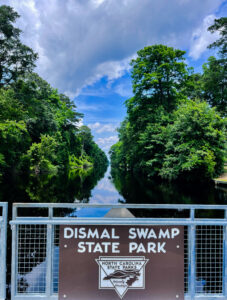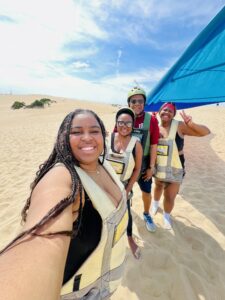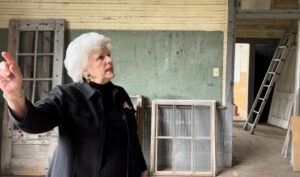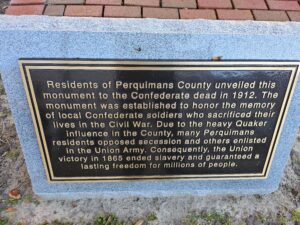By Bridgette A. Lacy
When Richard Etheridge peered out of the tower of the Pea Island Lifesaving Station that he commanded, he could hardly see for the blinding storm, what we would call a hurricane today.
That Sunday night in October 1896 was going to be cold and long.
Strong northeast winds whipped around the station, located on the northern shore of Hatteras Island.
Etheridge, a Dare County native, a Civil War veteran, was the first black to be appointed Keeper of a U.S. Lifesaving Service station, and he was the first of a line of black commanders at the Pea Island Station that lasted more than six decades.
This particular Sunday night, he and his all-black crew were not going to win any medals, but their heroics would be etched in history.
Caught in the storm was the E.S. Newman, a 393-ton schooner, captained by S.A. Gardiner, en route from Providence, R.I., to Norfolk, VA.
Gardiner was traveling with eight other people, including his wife and 3-year-old child.
The three-masted schooner ran into the hurricane, which ripped its sails away and caused the vessel to blow 100 miles off course, into the seas that were the responsibility of Etheridge and his team.
Surfman Theodore Meekins scanned the turbulent waters from the Pea Island watch tower, where he was on duty from dusk to 9 p.m. The darkness of night, the blowing sand and the raging storm made it hard to see.
Meekins thought he saw a flicker of light to the south of the lifesaving post.
The surfman set off a flare. If there was a sinking vessel on the Atlantic Ocean, Meekins wanted to signal the crew that they had been spotted.
The history:
The U.S. Lifesaving Service was established in 1848 to provide rescue services to all of America’s coasts. The service was merged with the U.S. Cutter service in 1915 to form the U.S. Coast Guard.
The lifesavers’ unofficial motto was, “You have to go out, but you do not have to come back.”
Richard Etheridge, who grew up on the water in Dare County, came to the Lifesaving Service with some command experience already. He had served in the Civil War as a Buffalo Soldier – the first black cavalry regiment in the U.S. military.
After the 1864 Chaffin’s Farm fight near Petersburg, VA, Etheridge was promoted to sergeant. The skirmish led to the capture of Richmond, the Confederate capital.
When Etheridge and other African American soldiers were cheated of their rations and their families were mistreated by white Union Army soldiers, Etheridge didn’t let the offenses pass. He wrote to Gen. Oliver O. Howard, the commissioner of the Freedmen’s Bureau in Washington, DC.
“Our families have no protection, the white soldiers break into our houses, act as they please, steal our chickens, rob our gardens and if anyone defends theirselves against them, they are taken to the guard house.”
Where others failed:
After the war, Etheridge returned to Nags Head Township, married, and resumed his life as a fisherman and a surfman.
The all-black Pea Island lifesavers which he ultimately came to lead came into being because, individually, they were some of the best surfmen on the Atlantic Coast, and because the previous all-white crew, as many Lifesaving Stations were in that era, came under scrutiny for not responding to a distressed ship which contributed to the deaths of seventeen crew and passengers aboard. On Nov. 30, 1879, a British vessel went down near the Pea Island station. A follow up investigation discovered that the crew had failed to patrol the beach that day.
Lt. Charles F. Shoemaker, the officer who investigated the tragedy, recommended to the superintendent that Richard Etheridge be given the position of Keeper, after the previous crew was dismissed.
Etheridge had a reputation as one of the best surfmen on the coast. He had worked at the Bodie Island and Oregon Inlet lifesaving stations as a surfman – though not as the top leadership position of Keeper.
His ability to do the job overcame the color of his skin. In 1880, following Shoemaker’s recommendation, Etheridge became the first black Keeper of a U.S. Lifesaving Service station. At the time, there were 18 stations in North Carolina and 179 in the United States.
For the nearly 70 years that followed, Pea Island would be manned by all-black crews. Etheridge and his men inspired a generation of blacks to join the Coast Guard.
A reputation:
Etheridge’s station consisted of seven surfmen, including him. Each surfman had a number, a rank. If something happened to the Keeper, the No. 1 surfman was next in line.
At “checkerboarded” stations, those that were integrated, black surfmen usually served low on the totem pole. They were generally numbers five and six, and performed menial duties, including cooking.
Etheridge was known as a sharp-eyed leader who kept a clean station, who drilled his men constantly and kept his equipment in good working condition. His station was constantly mentioned by inspectors as being one of the finest on the coast.
Etheridge understood the burden of being the first black to have such a respected position. He made sure that no one could question the ability of his crew.
Etheridge was well-prepared for his role. He grew up listening to the crash of the ocean. When Etheridge was born in 1842, Dare County was an isolated stretch of land where fishing was the chief industry. So as a boy he learned to fish and respect the power of the water. As a man, Etheridge was as much a disciplinarian with himself as he was with his surfmen. He was in good shape, and when he was appointed, he was described as “of strong and robust physique, intelligent and able to read and write sufficiently well to keep the journal of the station.”
The Pea Island surfmen patrolled the beach from sundown to sunup. One of Etheridge’s surfmen would carry a lantern as he walked north to Oregon Inlet and another surfman would walk south to the New Inlet station. The men would exchange badges with men from the other stations, then turn right around and return to their outpost.
The numbered badges were logged by Etheridge and served as proof that his men actually walked their patrol area.
Etheridge’s journal entries, made four times a day, also included how many boats or vessels passed in a given day and weather conditions.
As the men walked the 3 1/2 miles out and back, they would be looking for flares in the darkness and listening for the sound of ripping sails. They were also searching for debris that might indicate a ship in trouble.
On the stormy night of Oct. 11, 1896, the weather was so bad that Keeper Etheridge suspended the foot patrols.
In the station log, he recorded in his near-perfect penmanship that the weather at sunrise was “fresh N.E. gale, Stormy,” and at noon, “fresh, N. Hurricane, Stormy.”
Meekins was on watch in the station’s tower, and when he saw what he thought was a distress signal, Etheridge’s log recounts, he “immediately answered” with a flare. Summoned by Meekins, Etheridge “burned a red rocket, which was answered again with a red torch light. Then it became an evident fact that some vessel was stranded on the beach.”
“The keeper,” Etheridge records, “at once mustered the crew and with the team [of] a pair of good mules started to the scene of disaster with the hand cart and driving cart.”
One of the carts contained a small cannon that would shoot a line across to the wreck. The people on the sinking vessel would put the line on specific places on the ship. Wooden planks with instructions were attached to the initial line. Another line was sent out as well. That line was attached to a breeches buoy and a round life ring. A person would sit in the breeches attached to the life ring and be pulled off the wreck by the lifesavers.
If the vessel was further out in the ocean, the lifesavers would row a boat to the wrecked vessel and rescue people as best they could.
But this night, Etheridge wrote, “It seemed impossible under such unfavorable circumstances to render any assistance.” They found the schooner “well upon the beach, with head sails all blown away, cabin stove in and its effects greatly demolished, yawl boat [lifeboat] lost.” Keeper Etheridge was unable to get a line on the Newman from shore. The raging waters thwarted his every attempt.
So, Etheridge decided to tie heavy lines to his strongest surfmen and “let them go down through the surf as near the side of the vessel as possible.”
Meanwhile, the other surfmen held on tightly to the lines that were attached to the men.
When the surfmen got close to the wrecked vessel, the Newman crew threw out a ladder and “each survivor with a line around their body with great difficulty was carried back on the beach.”
The surfmen repeated the ritual until all nine people on the ship were off.
Etheridge wrote in the Pea Island station that night, “The voice of gladden hearts greeted the arrival of the station crew.”
It took Etheridge’s men until 1 a.m. to rescue all nine people on the ship.
Etheridge remained keeper at Pea Island Station until his death in 1900. He and his family are buried on the grounds of the North Carolina Aquarium on Roanoke Island, land the family once owned
In homage to the all-black lifesaving crews, the Coast Guard named a 110-foot patrol boat after them. The Pea Island, christened in 1992, was based in Mayport, FL where it served as a border patrol vehicle.
Here are some places to check out in Manteo:
- The Pea Island Cookhouse Museum located on Sir Walter Raleigh Street at Collins Park, a small park a few blocks opposite downtown Manteo. Click here for information about hours.
- The gravesite of Richard Etheridge at the North Carolina Aquarium at Roanoke Island. Click here for tickets and more information.
- James Melvin, artist, book illustrator. Melvin’s paintings of the Pea Island Lifesavers can be found throughout the area. To make an appointment to see his studio, call 252-441-5319; artistmelvin48 AT charter.net.
- Fort Raleigh National Historic Site exhibits on the Freedmen’s Colony and Roanoke Island during the Civil War.
Bridgette A. Lacy, a feature and food writer, is the author of Sunday Dinner, a Savor the South cookbook by UNC-Press. Her book was a 2016 Finalist for the Pat Conroy Cookbook Prize, Southern Independent Booksellers Alliance







